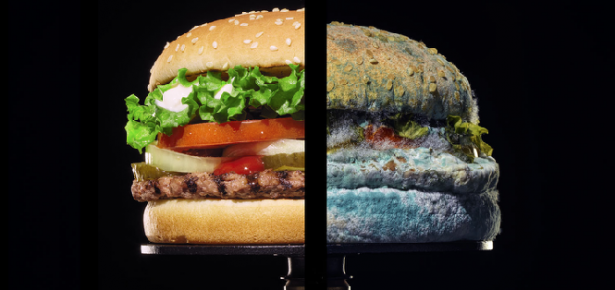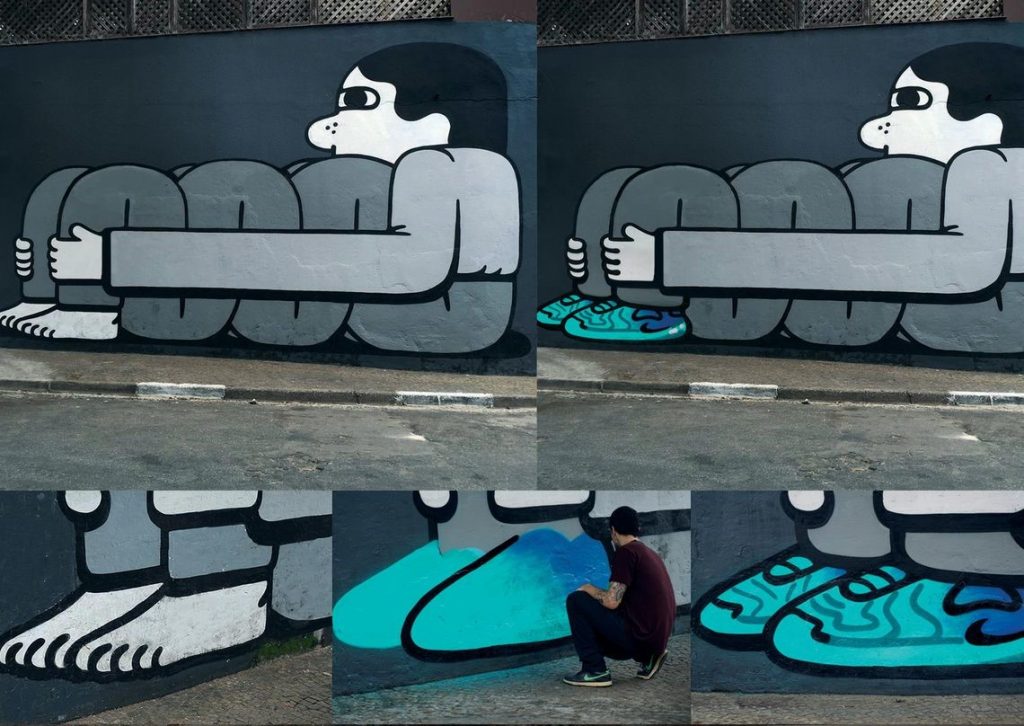
Much of the advertising we see and hear attempts to portray a product or brand in a positive light. Figurative devices such as metaphor and metonymy are often used in advertising to portray a product in connection with another, more desirable, idea. For example, many car advertisements use metaphor to compare a vehicle as a wild animal, such as a wild cat, horse, or even a rhinoceros (Figure 1), as they draw on relatable qualities such as strength, agility, and durability that are desirable in a car.

However, not all advertising is sweetness and light. In fact, sometimes the most striking adverts appear when brands go against this positivity bias, and instead draw our attention to hard-hitting, serious topics in a shocking way (in a strategy known as ‘shockvertising’). For years, charities combatting social issues (e.g. poverty, abuse, or deforestation) have made use of figurative devices to convey messages in a way that is unavoidably thought-provoking (such as the shockvertisement in Figure 2, that makes us reflect on the fact that the reckless chopping down of trees will lead to the extinction of the animals that live in that ecosystem). The goal behind this kind of advertising is to denounce an unfair situation, rather than to sell a product per se (although there is always a call for action involved, so there is some sort of persuasion to be expected).

Research has shown that, whereas positive messages are more memorable, negative advertising attracts more attention by describing a problem that the product may resolve (Bolls, Lang, and Potter 2001). Recently, successful brands have been taking the lead from charities by presenting unusual (often negative) ways of thinking about their products and societal issues. But these campaigns also carry considerable risk: might they be counterproductive and rather than attracting attention, might generate rejection by their targeted audiences?
Here we touch on three examples of award-winning campaigns that use figurative devices to convey controversial messages. They employ ‘negative advertising’ in an attempt to present a positive message about their product.
Welcome to the Black Supermarket – Carrefour (2018)
A brand making a stand against the law is taking a huge risk. But in 2018 the campaign ‘Black Supermarket’ by Carrefour, a French supermarket chain, directly challenged a European law that banned the sale of 97% of locally grown produce from seed varieties of fruits and vegetables by selling this illegal produce in their stores.
The play on the words ‘Black Supermarket’ evokes the idea of the ‘Black Market’. Carrefour’s campaign worked on both a literal and metaphorical level by selling illegal produce instore whilst framing it as organised crime. This metaphorical scenario portrayed the fruits and vegetables as prohibited goods, as if they were drugs or alcohol. In their adverts, Carrefour showed supportive farmers in criminal ‘mug shots’ (Figure 3), and showed footage of smugglers delivering produce to stores during the night along with ‘suspicious’ meetings and dealings in car parks.
This is a high-risk advertising strategy as consumers are unlikely to have a moral affinity with criminality. How did Carrefour handle it? The company incorporated consumers into the metaphorical scenario by encouraging them to ‘support the cause’ by buying produce sourced from local farmers, thus reframing the original negative message in a more positive way. It portrayed the ‘little guys’ (e.g. the farmers, the public and indeed Carrefour itself) as pitching together against the ‘big guys’ or ‘ruling elite’ (e.g. the bureaucrats of Brussels, Paris, and the European Union). The campaign’s timely release, when the political climate in France was characterised by strong anti-EU sentiment, the campaign was a success, and won the ‘Creative Effectiveness’ Prize in the 2019 Cannes Lions Festival.

Graffiti Store Counter-movement – Nike (2019)
After the Brazilian government began erasing cultural characters graffiti-ed on the streets of São Paulo, Brazil, international sports brand Nike, in collaboration with a graffiti collective AKQA, started painting the town – literally – to reinstate the characters, but this time depicting them wearing the new Nike AirMax trainers (Figure 4). Figuratively, the graffiti characters acted as a point of access to the much wider concept of the Brazilian street culture (a visual metonymy), and in turn, the AirMax stood for the brand Nike. Combining these metonymies in one image, Nike associated itself with the values of the art collective, and its trainers with the street culture of the capital. Customers could pre-order the trainers when near a character wearing the desired shoes, detected through geolocation technology as ‘graffiti stores’. Even though this campaign directly challenged government policies, the it led to a significant increase in ecommerce. The campaign changed the perception of graffiti from vandalism to cultural heritage that resulted in the ban being revoked. The campaign won the Grand Prix at the 2019 Lions Cannes Festival.

Mouldy Whopper Burger anyone? – Burger King (2020)
In 2020, Burger King posted a time-lapse of their Whopper Burger going mouldy (Figure 5). As a consumer, a mouldy burger sounds revolting, but in the advertising world, this campaign was ground-breaking. Typically, fast food companies aim to portray their edible items in the best light possible – often quite literally modelling food with expert photographers and Photoshop at the ready. Despite the negative appearance of a mouldy Whopper, Burger King used this image to demonstrate the fact that their burgers contain all natural ingredients and no artificial preservatives. By contrasting these images with their competitors’ ‘airbrushed and artificial’ food products, Burger King used an undesirable image of the Whopper Burger to draw attention to its fresh and organic ingredients.

Conclusion
Campaigns such as these go well beyond conventional advertising techniques. Although not without criticism, this high-risk (and potentially high-gain) strategy is effective in developing brand identity and in strengthening the relationship with the customer base by inviting consumers to play an active part in a metaphorical scenario closely related to real-world events and sentiment. A controversial campaign can position a brand in a way that distinguishes it from its competitors, resonating with the shared values of its customers.
Further insights can be found in our book Unpacking Creativity: The Power of Figurative Communication in Advertising, which is accessible for both advertising professionals and researchers.
Figures
Figure 1. An advertisement presenting a rhinoceros as a metaphor for a powerful engine in a Mitsubishi car, source: https://www.adforum.com/creative-work/ad/player/34444477/rhino/mitsubishi
Figure 2. An advertisement presenting a beheaded leopard as a metaphor for the destruction of wildlife due to deforestation, source: https://www.artfido.com/the-terrible-effects-of-deforestation-exposed-in-brutal-print-ads/
Figure 3. Farmers supporting Carrefour’s ‘Black Supermarket’ campaign presenting as ‘mug shots’, source: https://activationideas.com/blog/the-black-supermarket
Figure 4. Nike teamed up with Instagraffiti to reinstate Brazilian graffiti characters wearing AirMax trainers, source: https://unblock.coffee/campaign/air-max-graffiti-stores/
Figure 5. Burger King’s timelapse of their mouldy Whopper Burger, captioned ‘The beauty of no artificial preservatives’, source: https://ourcommunitynow.com/promotions/whats-up-with-the-moldy-whopper
Latest Comments
Have your say!